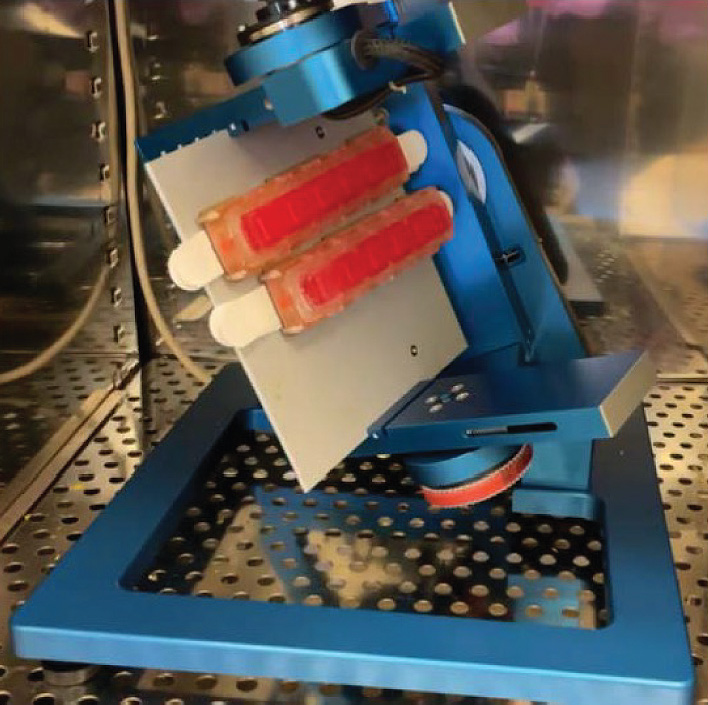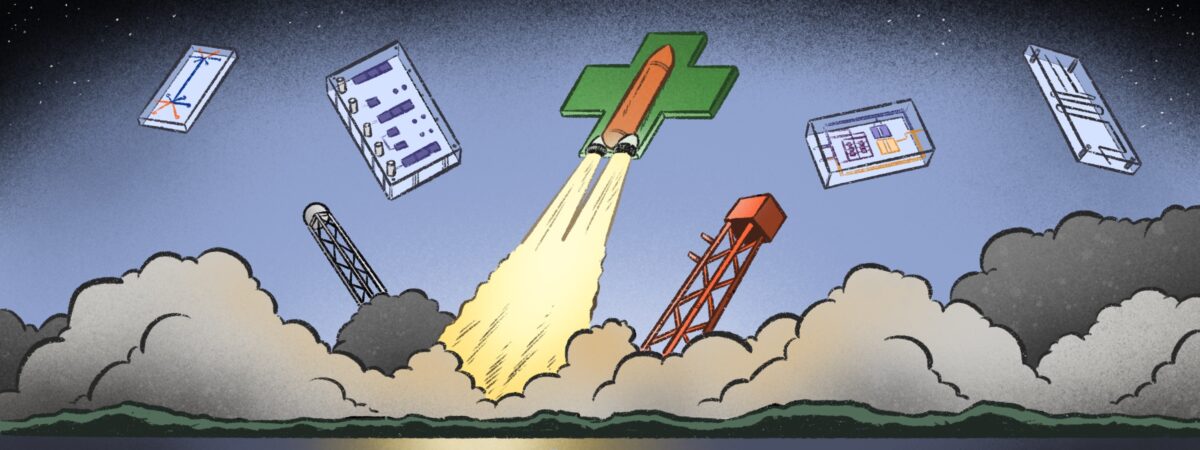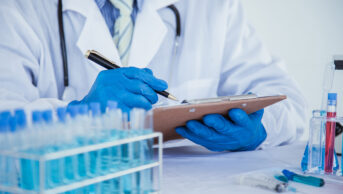Owing to the kidney’s important role in drug metabolism, pharmacy researcher Catherine Yeung has spent a lot of her career thinking about them. But she never expected this interest to land her at the Kennedy Space Center — twice — to watch her kidney experiments blast off into space on a rocket.
“Watching the launch was spectacular,” Yeung says about the first launch, which occurred at night. “The whole sky lit up, and we could feel the pressure waves in our chests because there’s so much power when a rocket launches.”
Yeung’s research at the University of Washington’s School of Pharmacy investigated basic physiology of kidney cells and included development of an in vitro ‘tissue chip’ device that mimics some aspects of kidney cell function. The resulting kidney chips are a collaboration with Edward Kelly, another pharmacy researcher at the University of Washington.
When the kidney chips made it to the International Space Station (ISS) in 2019 and again in 2021, the astronauts put them through their experimental paces. Over two decades, astronauts aboard the ISS have conducted thousands of experiments, and they have provided essential data about how space changes human physiology1. Many of these changes resemble ageing, such as bone and muscle loss, kidney dysfunction, immune system weakening and genomic instability. Although these effects can reverse upon return to Earth, the speed with which they take hold in space suggests that doing experiments there can accelerate age-related processes. For Yeung and colleagues, their ISS data could provide insights into normally slow processes that afflict people on Earth, such as kidney stone formation and the development of chronic kidney disease.
We can’t do these sorts of ageing experiments on [the] ground … can we use space as a shortcut?
Catherine Yeung, pharmacy researcher, school of pharmacy, University of Washington
“We can’t do these sorts of ageing experiments on [the] ground because you’d need an unaffordable number of people for 50 or more years,” Yeung says. “So can we use space as a shortcut?”
Recognising this potential, the US National Institutes of Health (NIH) launched the ‘Tissue chips in space’ programme in 2017, with nearly US$11m awarded to nine research groups to develop and send human tissue chip devices to the ISS on two spaceflights.
Although they are expensive, the experiments could offer a chance to reveal new aspects of human biology that can benefit both astronauts and people on Earth.
Seven years in, a lot has been learned. Most lessons revolve around the feats of engineering that allowed tissue chips to make the trip to and from space intact, in a payload small enough to fit aboard the ISS, with reagents permitted on the station.
While many results are still pending, initial findings show that these tissue chip devices in space sometimes recapitulate aspects of ageing in organs, such as the heart and kidney, and in other physiological systems, such as knee joints and the immune system. Several experiments have also conducted drug screens to test whether drugs can counteract the effects of space on cells, with implications for people on Earth and beyond.
“These first flights were really a proof of concept where we asked, ‘Can we actually run these experiments in space?’,” says Danilo Tagle, director for the Office of Special Initiatives at the National Center for Advancing Translational Sciences (NCATS), the branch of the NIH that partnered with ISS for this programme. “And the answer is, to some degree, yes.”
Preparing tissue chips for space
Tissue chips are simplified in vitro systems that mimic aspects of a body’s physiology. Also known as microphysiological systems (MPS), tissue chips combine live cultured cells with microfluidic channels that carry fluid to and from the cells, allowing control of the cellular environment and access to cellular outputs. Credit card-sized or smaller, these devices allow the study of specific parts of complex physiology.
Tissue chips containing human cells also offer a valuable tool to screen drugs for humans. Given the poor track record of animal model results translating to human clinical trials, NCATS has been promoting tissue chips containing human cells as a way to improve screening for drug efficacy and safety in humans.
While tissue chips offer plenty to study on Earth, sending them to space could bring scientific dividends for everyone.
When astronauts are exposed to microgravity for prolonged periods, they undergo physiological changes similar to ageing
Danilo Tagle, director for the Office of Special Initiatives, National Center for Advancing Translational Sciences
“When astronauts are exposed to microgravity for prolonged periods, they undergo physiological changes similar to ageing — but it happens with a much more accelerated timeline,” Tagle says.
“Ageing is probably one of the hardest things to model because of the time that it takes. Animal models take years, if not decades, to go through the process of ageing, and only then can you study what ageing-related conditions are,” he adds.
Identifying what the molecular changes are in space in diverse human tissues could yield new targets for drug development that may eventually be used to mitigate ageing.
But first, just getting tissue chips that could withstand the rigours of spaceflight to the ISS and back require a lot of engineering. The ISS floats in low Earth orbit some 250 miles away from Earth. There, the station environment does not receive much space radiation, but microgravity is in full force. Working with engineering outfits called “implementation partners,” the researchers had to miniaturise the chips and their incubators to fit onto the ISS. For Yeung, this meant going from a kidney chip incubator the size of a refrigerator to something more like a shoebox2.
Other design innovations strengthened the chips so they could withstand the excessive gravity and vibration during launch, sealed the chips so that culture media would not float away in microgravity, and added features to facilitate the ability of busy astronauts to carry out the experiments without too much fuss.
“Here on Earth we have the luxury of having research technicians babysit the experiments, but up there the experiments need to be more or less plug and play,” Tagle says.
Even with these considerations, some tissue chips returned from space cracked, delaminated or contaminated with mould. Ultimately, only seven of the projects were able to go on the second spaceflight.
The successes warrant renewed funding, with NCATS planning to issue a request for applications in autumn 2024. These will focus on identifying measures to mitigate the effects of ageing. The National Institute of Aging has also started to collaborate with NCATS, and hosted a workshop in summer 2024 focused on using MPS in space to study ageing.
Organs on chips
Yeung’s kidney chip contains proximal tubule epithelial cells obtained from human kidneys deemed not suitable for transplant surgeries. On the chip, these cells simulate a proximal tubule by forming a tubular structure, and by expressing proteins responsible for reabsorption and secretion. This setup can address basic questions about kidney function in health and disease.
“I’m a pharmacist, and I know it’s really hard to use medication in people with kidney disease,” Yeung says. “We don’t even know if a drug is cleared faster or slower in these patients.”
Given the rare opportunity to do science in space, the researchers packed a lot of experiments into their tissue chips. For Yeung and Kelly’s team, their first spaceflight experiments investigated kidney physiology under stress to model the early stages of chronic kidney disease, as well as the kidney’s role in bone loss, given how its metabolism of vitamin D can influence calcium absorption. Their second spaceflight focused on kidney stone formation.
In a new paper, the team reports that the stint in space did not enhance measures of stress or problems with vitamin D metabolism in the human kidney cells on the chips3. Compared with ground control chips, the ISS kidney chips showed similar changes in biomarkers of kidney injury, vitamin D metabolites in effluents, and differentially expressed genes. One marker of pro-inflammatory stress, IL-6, was slightly higher in space than on the ground, but it did not reach statistical significance.
“I think the big question for us is whether the increase in IL-6 is a sign of some sort of pathology or a healthy adaptation to the new environment,” Yeung says.
The lack of effect could be owing to the short timeline: the tissue chips had one week to acclimate to microgravity, then received a two-day exposure to test agents, either serum proteins as a kidney stressor or vitamin D.
Human heart cells have also made two trips to space and back. Based on signs of diminished cardiac function in astronauts after a prolonged period in space, Deok-Ho Kim, a biomedical engineer at Johns Hopkins University, and his team sent tissue chips containing human heart muscle cells in 2020 and again in 2023.
The heart muscle cells are grown between two small rods within a well filled with cell culture media (see photograph). One rod is rigid and the other is flexible, and can move when the muscle cells contract. A magnetic sensor records deviations by the flexible post, and thus measures muscle contractions in real time.

Deok-Ho Kim
The first spaceflight tissue chips returned data that confirmed ageing-like effects of microgravity: twitch forces decreased with time, and signs of arrhythmia, oxidative stress and mitochondrial dysfunction developed4. On the second spaceflight, the muscle cells were exposed to one of three FDA-approved drugs — Kim declined to say which because the paper is currently in press — to see if they might stall microgravity’s effects. To help choose which drugs to try, the researchers pre-tested eight drugs on the tissue chips strapped into a random positioning machine that simulates microgravity5.
Without addressing this issue, no one will want to travel to Mars
Deok-Ho Kim, biomedical engineer, Johns Hopkins University
These experiments could suggest countermeasures for weakened heart health as people age on Earth, as well as for astronauts. This problem is particularly critical for future travellers to Mars, who are projected to lose more than 50% of their muscle and bone mass.
“Without addressing this issue, no one will want to travel to Mars,” Kim says.
Painful joints
Beyond organs, tissue chips can mimic physiological interactions between different cell types to model other age-related changes, such as post-traumatic osteoarthritis (PTOA). In this condition, a joint injury initiates inflammation and cytokine release, followed by slow degradation of cartilage, which may eventually manifest as painful arthritis years later. Although osteoarthritis affects more than 600 million people worldwide, there is no cure.
To study the processes involved in PTOA, Alan Grodzinsky, a biological engineer at the Massachusetts Institute of Technology (MIT), and his colleagues developed a tissue chip containing knee-cartilage bone plugs and associated connective tissue called synovium harvested from human cadavers. Once the cartilage-bone-synovium cultures are established, a controlled injury to the cartilage results in increases in inflammatory cytokines and signs of cartilage breakdown6.
Given the tendency for the space environment to speed things up, it seemed possible that it could accelerate degradation after a joint injury.
If you could discover the initiating events for post-traumatic osteoarthritis, you might be able to block disease progression
Alan Grodzinsky, biological engineer, Massachusetts Institute of Technology
“If you could discover the initiating events [for PTOA], you might be able to administer a drug that could block the progression of the disease, instead of just treating the pain 20 years later,” Grodzinsky says.
Results from the launch in 2020 show similar results in space as on Earth, with the same molecules being released in the synovial fluid after injury, such as a component of cartilage called aggrecan. Differences emerged for the complement of metabolites released in space, particularly those associated with oxidative stress and inflammatory pathway activation. Proteomic analyses of the cells also found increases in the release of extracellular proteins and collagens in space7.
“I’m not sure there [are] enough data yet to say that it was significantly faster in space, but I think it is important that we saw that similar processes occurred,” Grodzinsky says.
The team also tested dexamethasone and insulin-like growth factor-1 (IGF-1) to see if they could slow these processes, with some promising results8. These could be helpful to people with injuries on Earth, as well as to astronauts, for whom exercise-related injury is the most common type of injury on the ISS.
To boldly go
With an eye on missions to the moon and to Mars, the National Aeronautics and Space Administration (NASA) has funded nine research groups — including Yeung and Kim — to extend the viability of the cells in their tissue chips to six months or more on the ground.
I’d like to send these model systems to deep space, so we can understand the adaptation that’s happening in astronauts
Lisa Carnell, director, Biological and Physical Sciences division, NASA
“I’d like to send these model systems to deep space, or to the space station for an extended period of time so that we can understand the adaptation that’s happening in astronauts, and how we might be able to intervene therapeutically,” says Lisa Carnell, director of the Biological and Physical Sciences division at NASA.
Although her priority is to find ways of keeping astronauts healthy while in space, Carnell says everything that is learned has applications on Earth. This is because space is inherently stressful to cells, and their reactions and adaptations to these stresses can highlight new pathways or signals that may not be evident on Earth.
This potential was realised in cancer cells sent to space: aboard the ISS, cancer cells proliferated more quickly, in part owing to fewer structural constraints found in a microgravity environment. This helped researchers identify a driver of this proliferation and a drug candidate called rebecsinib to block it9.
Buoyed by this kind of success, in July 2024, NASA and the ISS announced an ‘Igniting Innovation’ programme focused on cancer research in space.
Drug manufacturing has also benefited from studies in microgravity, with improved protein crystallisation found for Merck’s cancer drug pembrolizumab aboard the ISS. Merck has since adapted manufacturing techniques on Earth to simulate aspects of microgravity, which optimises crystallisation of the drug10.
With the planned closure of the ISS in 2030, Carnell is focused on making sure the science will continue on commercial space labs in line to take the ISS’s place. “I think we’ve only begun to scratch the surface of the value of doing this type of research that can ultimately benefit life on Earth,” she adds.
- 1.Garrett-Bakelman F, Darshi M, Green S, et al. The NASA Twins Study: A multidimensional analysis of a year-long human spaceflight. Science. 2019;364(6436). doi:10.1126/science.aau8650
- 2.Jones-Isaac K, Lidberg K, Yeung C, et al. Development of a kidney microphysiological system hardware platform for microgravity studies. NPJ Microgravity. 2024;10(1):54. doi:10.1038/s41526-024-00398-0
- 3.Lidberg K, Jones-Isaac K, Yang J, et al. Modeling cellular responses to serum and vitamin D in microgravity using a human kidney microphysiological system. NPJ Microgravity. 2024;10(1):75. doi:10.1038/s41526-024-00415-2
- 4.Mair DB, Tsui JH, Higashi T, et al. Spaceflight-induced contractile and mitochondrial dysfunction in an automated heart-on-a-chip platform. Proc Natl Acad Sci USA. 2024;121(40). doi:10.1073/pnas.2404644121
- 5.Ren Z, Ahn E, Do M, et al. Simulated microgravity attenuates myogenesis and contractile function of 3D engineered skeletal muscle tissues. NPJ Microgravity. 2024;10(1):18. doi:10.1038/s41526-024-00353-z
- 6.Dwivedi G, Flaman L, Alaybeyoglu B, et al. Inflammatory cytokines and mechanical injury induce post-traumatic osteoarthritis-like changes in a human cartilage-bone-synovium microphysiological system. Arthritis Res Ther. 2022;24(1):198. doi:10.1186/s13075-022-02881-z
- 7.Dwivedi G, Flaman L, Alaybeyoglu B, et al. Effects of dexamethasone and IGF-1 on post-traumatic osteoarthritis-like catabolic changes in a human cartilage-bone-synovium microphysiological system in space and ground control tissues on earth. Front Space Technol. 2024;5. doi:10.3389/frspt.2024.1358412
- 8.Livingston S. From Root Cause to Remedy: Can Microgravity Help Prevent Post-Traumatic Osteoarthritis? Upward: Magazine of the ISS National Lab. April 23, 2024. Accessed September 27, 2024. https://www.issnationallab.org/upward71-mit-grodzinsky-ptoa/
- 9.Crews L, Ma W, Ladel L, et al. Reversal of malignant ADAR1 splice isoform switching with Rebecsinib. Cell Stem Cell. 2023;30(3):250-263.e6. doi:10.1016/j.stem.2023.01.008
- 10.Reichert P, Prosise W, Fischmann T, et al. Pembrolizumab microgravity crystallization experimentation. NPJ Microgravity. 2019;5:28. doi:10.1038/s41526-019-0090-3


